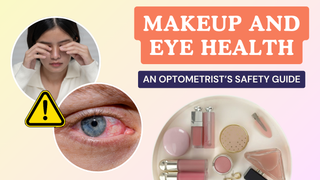Introduction
Understanding your eye prescription is crucial for choosing the right contact lenses. This knowledge helps ensure optimal vision correction and comfort. In this guide, we'll break down the key components of an eye prescription, explain common abbreviations, and highlight the importance of regular eye exams.
What Is an Eye Prescription?
An eye prescription is a detailed document provided by an eye care professional that outlines the specific vision correction needed for each eye. It's essential to note that there is a difference between eyeglass prescriptions and contact lens prescriptions. Contact lens prescriptions include additional details required for proper lens fitting.
Key Components of an Eye Prescription
OD and OS
OD (Oculus Dexter) refers to the right eye, and OS (Oculus Sinister) refers to the left eye. These Latin terms are used to treat each eye separately, ensuring precise vision correction.
Sphere (SPH)
Sphere (SPH) indicates the lens power needed to correct nearsightedness or farsightedness. A minus (-) value denotes myopia (nearsightedness), while a plus (+) value indicates hyperopia (farsightedness).
Cylinder (CYL)
Cylinder (CYL) corrects astigmatism, which is caused by an irregularly shaped cornea. The CYL value can be minus (-) or plus (+), depending on the type of prescription format used. Eyeglass prescriptions can be written in either in plus cylinder format or minus cylinder format. Although an eyeglass prescription may look very different in one format versus the other, the two actually represent identical prescriptions. Contact lenses are always written in minus cylinder form.
Axis
Axis defines the orientation of astigmatism correction and is measured in degrees, ranging from 0 to 180. It specifies the direction of the cylindrical power in the lens.
Add Power (ADD)
Add Power (ADD) is used in bifocal and multifocal lenses to correct presbyopia, which affects near vision. It indicates the additional magnifying power required for reading and close-up tasks.
Base Curve (BC)
Base Curve (BC)measures the curvature of the central back surface of the contact lens. For eyeglass lenses, the base curve is the curvature of the front surface of a lens. It is crucial for fitting the lens comfortably on the eye and maintaining proper vision correction. The BC value ensures the contact lens conforms to the natural shape of your eye.
Diameter (DIA)
Diameter (DIA) specifies the overall size of the contact lens. The DIA value ensures that the lens covers the cornea adequately for optimal vision correction and comfort.
Reading Your Eye Prescription
Interpreting your eye prescription involves understanding each component. Let's break it down step by step:
1. OD and OS: Refers to your right and left eyes, respectively.
2. Sphere (SPH): Note the SPH value for each eye to understand the degree of nearsightedness or farsightedness.
3. Cylinder (CYL) and Axis: Check the CYL and Axis values if you have astigmatism.
4. Add Power (ADD): Look for the ADD value if you need bifocal or multifocal lenses.
5. Base Curve (BC) and Diameter (DIA): Ensure the BC and DIA values match the specifications for your contact lenses.
OD: Right Eye
OS: Left Eye
SPH: Sphere
CYL: Cylinder
AX: Axis
ADD: Add Power
BC: Base Curve
DIA: Diameter
Differences Between Eyeglass and Contact Lens Prescriptions
Eyeglass prescriptions differ from contact lens prescriptions due to the additional measurements needed for contact lenses. Usually, the sphere power and cylinder are different between the eyeglass and contact lens prescriptions. Since contact lenses sit directly on the eyes, the sphere power will differ, especially for higher power prescriptions. Contact lenses typically have limited cylinder powers, so cylinder power may vary between the eyeglass and contact lens prescriptions. Contact lens prescriptions include the base curve (BC) and diameter (DIA), which are essential for fitting lenses on the cornea. Always consult an eye care professional to ensure you have the correct prescription for your contact lenses.
Importance of Regular Eye Exams
Regular eye exams are vital for maintaining accurate prescriptions and overall eye health. During an eye exam, an eye care professional can detect changes in your vision and update your prescription accordingly. Regular check-ups also help identify potential eye conditions early, preventing severe vision problems.
"Regular eye exams not only keep your prescription current but also allow early detection of potential eye conditions," says Dr. David Jupiter, O.D. "This can significantly reduce the risk of vision loss”.
What to Expect During an Eye Exam
A comprehensive eye exam typically includes:
- Visual Acuity Test: Measures how well you can see at various distances.
- Refraction Test: Determines your prescription for glasses or contact lenses.
- Retinal Examination: Examines the back of your eye (retina) for signs of disease.
Understanding your eye prescription is essential for choosing the right contact lenses and maintaining good vision. Regular eye exams ensure your prescription is up-to-date, providing optimal vision correction and comfort. Explore EyeCandys' range of contact lenses to find options that suit your prescription and enhance your look.











